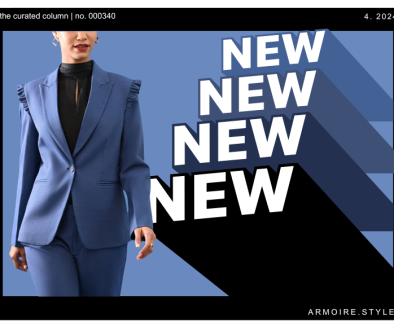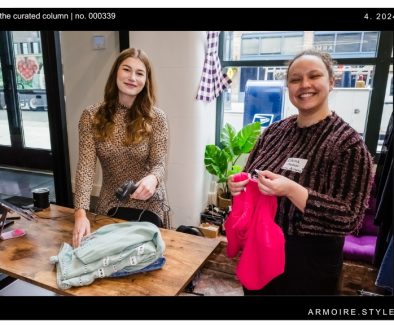Armoire Makes The ‘Clueless’ Closet A Reality
Even if you’re “not a math person,” here’s one reason to love numbers: data can curate your dream closet. At the intersection of fashion and technology, Seattle-based startup Armoire uses data to build personalized virtual closets for the modern woman. The “wardrobe as a service” curates a personalized selection of contemporary items, allows members to rent them for however long they’d like, and then swap out for a new set of items. The key aspect that sets Armoire apart from other rental services is their “fashion magic”: a machine-learning algorithm developed at MIT and now finding home in the closets of women across the US.
Big data is really trendy right now, but what Armoire deals with is actually a small data problem. In an ideal world, we’d know every woman’s preference on every single item of clothing, but as we all know, no one wants to spend hours scrolling through pages of inventory, or trying on a million items. So Armoire uses data to predict what members will like by matching them with items that other women with similar preferences have enjoyed.
As it turns out, finding your perfect closet can all come down to a bit of vector analysis and matrix math.
Here’s how it works:
1. Share Your Style


Each member who signs up fills out a style profile, which asks you to like/dislike a few items of clothing, then asks about the basics – height, sizing, fit preferences, favorite colors/prints, whether or not you’d wear a crop top, etc.
Liking/disliking items gives Armoire an idea of what you’ll like, and can then align you with women who also liked those things.
For items you haven’t seen/rated, Armoire fills in the gaps and predicts whether or not you’ll like the items, based on reactions from women with similar preferences. If you have similar taste to another woman, chances are you’ll like a shirt she also liked.
2. Choose Your Favorites

Quick math class throwback: Vectors are a quantity having a certain direction and length, mainly used to determine one point in space relative to another. So, as different preferences shift your “preference vector”, your vector moves to a different point in space.
Each member is shown a virtual closet based on preferences. This is where the math comes in, thanks to the geniuses on the Armoire algorithms team. Each customer is assigned a “preference vector” based on items she’s liked or disliked before. The vector is adjusted based on things like fit, prints, occasion, and brand.

Each item also gets its own vector. Based on reviews from other customers, Armoire can match your preference vector to an item it thinks you’ll like, so when you view your virtual closet, you’re only seeing a select number of items that have at least a 50% chance of you liking, with preference to newer items and seasonal items. You can choose four items to wear for the next week or two, a welcome change from hours of scrolling through endless pages of dresses just to find one you’re not even sure will fit.
3. Armoire Learns
Every time you like/dislike an item shown to you, or rate an item in your case, the algorithm learns about your preferences, and can more accurately predict what you’ll like next time. The more women use Armoire, the more data comes in for each item as well, making it easier to match women’s preferences to others with the same specific preferences. If a bunch of women who liked a dress you liked also liked a pair of jeans, you might see that pair of jeans in your next closet.
Style And Fit

ARTICLES OF SOCIETY Maternity Distressed Skinny Jeans
There are two pillars to finding you the right items: style and fit. While many companies focus on one or the other, Armoire finds that looking at both style and fit preferences allows each to evolve separately without disrupting a customer’s closet, and take into account natural fluctuations, such as pregnancy. Where the algorithm really shines is when it comes to sizing.
For example, you might say you’re generally an 8. But in reality, you might be an 8 in one brand, 6 at another, 10 at a third. Maybe you like things to fit more tightly, or your sweaters to fit more loosely, or tend to slim down half a size during the summer. It makes sticking to a single number look a little impractical.
Here’s where Armoire steps in with a clever solution. They know it’s not enough to prescribe your fit to one number across their inventory of 200+ brands and 10,000 items of clothing, so they look at size as a spectrum, not discrete integers. So maybe you are “an 8,” but as you rent their clothing, and then review your cases based on your fit and style preferences, the algorithm learns your true fit. If you rented a dress, and found it to be a bit too big in the waist (the biggest indicator of how an item fits!), the algorithm will match your fit to other members who rated the fit on that same dress similarly to how you rated it. This way Armoire can suggest things to you that fit that other member well, and therefore will probably fit you well, too.
If you think about it, this is already how we view clothing in our own closets. You probably have different sizes in your closet at home, or have ordered something online just to discover the fit is radically different than what you expected. The fit challenge is actually built into the way we shop. We all know that just walking into a store, grabbing the nearest size 8, and going home is almost never a guarantee, leading to an unfortunate amount of time spent in cramped dressing rooms or trips to the post office returning items ordered online.
As Armoire accumulates a deeper data set, both for members and items, the algorithm learns to predict fit and style preferences more accurately. Their deeper data set also allows it to take into account the more nuanced preferences as well (such as “requires a strapless bra” or “shows midriff”), often lost in other styling services.
Overall, using data makes service faster and more convenient. As a member, you don’t have to pour through the entire inventory to find what you like, only to worry if they’ll even fit (Think Cher Horowitz’s digital closet in Clueless). What does this mean for members? Clothes they’ll love, as soon as they need them, with no hassle. It’s a clever solution to a common problem, and a strong case for giving math a chance!
Want to unlock a personalized closet of your own? Start here by taking the Style Quiz!




